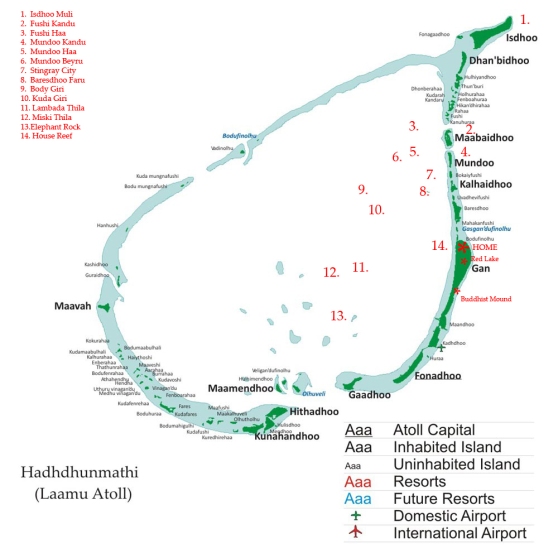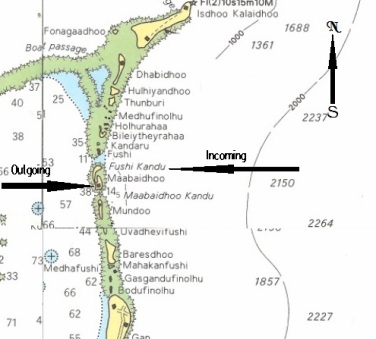
Click on the map to enlarge it
Diving in Laamu Atoll differs from the other atolls to the north. The atoll has relatively few channels allowing water to enter and escape the atoll, meaning there is less plankton inside the atoll, which reduces current and improves visibility. The reduced flow of water inside the atoll is both good and bad for divers. The bad news is that on a given dive site, bio-diversity is reduced. Plankton is made up of millions of organisms and pelagic (blue water) larvae and eggs. The upside is that you can still find a variety of different animals from Ghost Pipefish, tuna, through to sharks, schooling mobulas and mantas…… but probably not on the same site. Coral formations are also quite different in this atoll with massive structures of both hard and soft corals which thrive in certain conditions like ours.
For photographers, visibility and current are often critical factors for increasing the amount of ‘keepers’. Great visibility means improved light at depth which is very important to retain colours in underwater photos. Little current means it is much easier to take more time in setting up your shot, allowing for easier buoyancy control to avoid scaring the subject, and to avoid damage to the fragile reef.
The two channels (kandu) which lie approximately 45mins to the north of the Diving Center are a hotspot for pelagics such as sharks- grey reef, whitetip reef, silky, nurse, leopard (zebra), thresher and hammerheads can be seen here when the conditions are right. Usually those conditions mean a medium to strong incoming current where water flows from east to west. Some species such as hammerhead and thresher sharks are found in deep water, especially if there is a thermocline at about the 30m/100ft mark. Sharks are opportunistic feeders for the most part and like to hang about reefs where there is a sudden upwelling of water. What happens is a classic food-chain starting from the basic organisms like plankton to apex predators like tuna, sailfish…. and sharks.
It works a bit like this: Plankton is made up of algae (phytoplankton) and microscopic animals and fish larvae (zooplankton) which feeds on the algae which, like all plants need sunlight to grow, so phytoplankton is found mainly at the surface. Zooplankton feeds on the algae during the night when they’re relatively free of predation from fishes. At sunset the zooplankton moves up to the surface and at sunrise they swim back down to depths of around 100m/300ft. Currents hit the reef wall and flow through the channels and the zooplankton is swept along in to the waiting mouths of thousands of plankton eating fishes and corals. These plankton eaters make up the majority of biomass of coral reefs….but waiting for them are predators like tuna, barracuda and jacks or trevally. They are some of the fastest swimming fishes and strike at incredible speeds- sometimes scoring a direct hit and sometimes injuring themselves os other fishes in their attempts. Sharks are attracted to these strikes and have keen senses to distinguish injured fish which they will attempt to take. At night sharks also come in to their own as powerful predators.
To give you some kind of idea about the depths around the Maldives, have a look at this depth chart showing depths in meters around these two kandu, and the northern point Isdhoo Muli. When you can measure depth in kilometers, that means seriously deep water and you can throw in terms like ‘The Abyssal Plain’ which sound really cool. The Isdhoo peninsular in particular has incredible dropoffs only a stonethrow from the outer reef. Divers have reported seeing ‘mola mola’ or sunfish can be found around here at certain times of the year. These massive and mysterious fish are not normally seen near reefs, but perhaps the proximity to deep deep water means we can see deep water fishes like mola mola, thresher sharks and hammerheads.

Pingback: Dive Sites Complete - Maldives Complete Blog